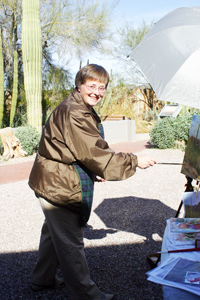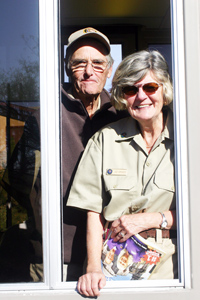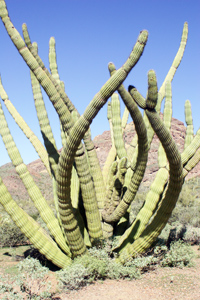The new version of Workamper.com is...
Read moreVolunteers Find A Spot Of Magic In The Sonoran Desert
Volunteers Find A Spot Of Magic In The Sonoran Desert
 “Welcome to my studio,” Volunteer Carol Miller says on the patio behind the Organ Pipe Cactus National Monument Visitor Center in the southern Arizona Sonoran Desert.
“Welcome to my studio,” Volunteer Carol Miller says on the patio behind the Organ Pipe Cactus National Monument Visitor Center in the southern Arizona Sonoran Desert.
“Painting is my favorite thing to do,” Carol continues, dabbing her brush at saguaro cacti on the canvas mounted on her easel. “When I paint one of the mountains here in the monument, I know that mountain. I’ve been staring at it for a long time.”
Carol and her husband, John, who also volunteers in the interpretive division of the monument, had visited from their home in Connecticut. Carol’s profession had been in accounting; John’s as a machinist. He saw his shop go from three shifts to one as work moved to China. The slowdown gave them the opportunity to start traveling and to apply as volunteers at Organ Pipe Cactus National Monument.
The Millers still maintain a house in Connecticut, but Carol sees them headed for full-timing. “When we bought our motorhome, I made sure I had storage for my paintings and supplies,” she says, pointing to a wooden box of oil paints on the patio next to her easel. “My grandfather gave me those paints for my 13th birthday, and I’ve painted ever since. I have a minor in art, have taught a few classes, and sold some paintings, but mostly I paint for myself.”
Carol was not accepted as a volunteer because of her painting talent, Volunteer Coordinator, Sue Walter says. “She happened to be one of the ‘gems’ dropped in our lap. We are using her talent in demonstrations twice weekly, two hours at a time.”
Walter explains that the Monument has different divisions that use volunteers: resource management, maintenance, visitor center, campground, and interpretive. She says Organ Pipe Cactus Monument has VIP campground space for 24 volunteers—if they are couples. They also have people who live locally and come in to volunteer. One local person demonstrates flint knapping, which is the making of arrowheads.
“We accept volunteers based on the park’s needs, but we have all sorts of people,” Walter continues. “Some do special projects, such as pronghorn wrangling. Others do hands on research; some get knee deep in muck researching pupfish. One couple pulls buffalo grass. Others do interpretive programs—patio talks, nighttime presentations at the amphitheatre, or the Ajo Mountain van tour.
“But they also have lots of fun,” she adds. “We give them good living conditions, always trying to upgrade each year. The volunteers have their own ‘gated’ community. We have a common building for them in which there are freezers for storing food, an extra refrigerator, showers and toilets, laundry facilities, and tables and chairs for potlucks, card playing, and folding laundry. We have Wi-Fi and a booster for cell service. Each campsite has full-hookups with 30 amp service.
She goes on to praise the group of volunteers, who can work a minimum of two months. However, the Monument staff likes to have volunteers stay for the winter season, November through March. The National Park Service provides shirts, jackets, and hats. Individuals must provide their own pants. “Different divisions in the park require different hours, but all put in more than the required 32 hours weekly for each couple,” she says. “Most couples split it 16/16 and they can do half days. The schedule is typically four days on, and three days off. Their work allows the rangers to get other projects done.”
“Different divisions in the park require different hours, but all put in more than the required 32 hours weekly for each couple,” she says. “Most couples split it 16/16 and they can do half days. The schedule is typically four days on, and three days off. Their work allows the rangers to get other projects done.”
Ken Hires, media specialist, lead volunteer, and park ranger, trains and coaches the volunteers. He adds that all divisions and rangers appreciate the work and dedication of their volunteers. “We could not operate without them,” he says.
Rorik and Sherri Rivenburgh, new full-timers from Albuquerque, New Mexico, arrived at Organ Pipe Cactus National Monument on November 15, only their second stint at Workamping.
“We had never camped; had never even been in an RV,” Sherri says, describing their pursuit of a different lifestyle after Rorik retired from UPS and she left a twenty-year career as a controller at two restaurants. “We started reading www.RVDreams.com and decided if those people can do it, we can, too.”
Everything fell into place. They sold their 2700 square-foot home and most of their possessions collected over 27 years. They shopped for an RV and settled on a fifth-wheel towed by a one-ton truck.
The Rivenburghs made their first RV trip to attend the Spring 2011 Workamper Rendezvous in Heber Springs, Arkansas. Armed with information and confidence, they took their first Workamping job with Forever Resorts at the North Rim of the Grand Canyon. The concessioner hired Sherri to work the cash vault, cashing pay checks. On the first day, she was promoted to person in charge of payroll for 25 people. Rorik was hired as sales associate for the gift shop, promoted to assistant manager, and then to manager. The couple worked May 15-October 15. Their employer furnished a site, free propane, and after their promotions, some free meals. Sherri adds: “We started above minimum wage; and saved all our earnings because we had no living expenses.”
During their first weeks at Organ Pipe Cactus National Monument, they worked in the Visitor Center, absorbing information. The volunteers’ official training started the week before Christmas. Sherri explains that in 64 hours of classroom time packed into eight days, those in interpretation, such as the Rivenburghs and the Millers, learned how to put a program together with emotional and intellectual connections. Each one chose a subject to research and develop. The training included a field trip on the Ajo Mountain Tour.
The staff started scheduling different volunteers for patio talks and evening presentations. “We were not given a script and we were required to have goals and themes,” Sherri says. “Interpreters give four different 15-minute patio talks. Some go on the Ajo Mountain Van Tour; one interprets, another drives. Some present the evening programs.” Sherri chose mistletoe as her subject for patio talks. Rorik researched javelinas. They had access to the library’s books and Internet in the Visitor Center. Previous volunteers have recorded files of photos which are available to all volunteers.
Sherri chose mistletoe as her subject for patio talks. Rorik researched javelinas. They had access to the library’s books and Internet in the Visitor Center. Previous volunteers have recorded files of photos which are available to all volunteers.
Judy and Walt Tormohlen visited three years ago and talked to other camp hosts. They said there were not many openings, but Judy and Walt sent an application and were accepted in 2011. Retired from their own business, Walt and Judy have maintained their permanent home in Pagosa Springs, Colorado, for 15 years. “We stay at home in the summer,” Walt says. “It’s hard to beat Colorado in summertime!”
Their duties as camp hosts include: running the kiosk, taking money for camping, assigning sites, and making sure campers abide by the rules. They rake tent sites, and sometimes trim bushes.
Walt and Judy pull a trailer so their motorcycle with a sidecar can ride in the back of their truck. For entertainment at the monument, they talk to people, hike, meet guests, and watch television. Walt says, “We enjoyed our first year here so much, we wondered if the second assignment would be as much fun. We think it is!”
Organ Pipe Cactus National Monument is isolated and shares 33 miles of international border with Mexico. Rorik and Sherri, and most other volunteers, to the town of Ajo, approximately 35 miles north, for groceries and supplies. “We thought we’d miss being in a community,” Sherri Rivenburgh says. “But we actually know our neighbors here in the VIP campground better than those we had for years in Albuquerque. Our site has the only fire ring in the campground and Rorik has been dubbed ‘Mayor of the evening fires.’ On days off, we enjoy hiking and being surrounded by the beauty of the desert.”
The volunteers and staff stress that Organ Pipe Cactus National Monument is a safe environment, despite its isolation. Although the monument is named for the rare organ pipe cactus, 28 species of cacti in all thrive in more than 330,000 of protected acres of the Sonoran Desert. Entering the National Monument property, one may be surprised how the desert environment changes from shifting sand dunes, salted fields, and scraggly dry plants to a lush, green environment.
A story is told that an apprehensive tourist approached a park ranger and asked: “What would you do here if you had only two hours to visit?” The ranger with a serious face replied, “Cry!”
And so it is at Organ Pipe Cactus National Monument. The wonders and beauty take time to discover. Volunteers have that time to become attune to the plants and wildlife, the people who visit, and the legacies of those who once lived there. Most agree that the monument is a spot of magic.


